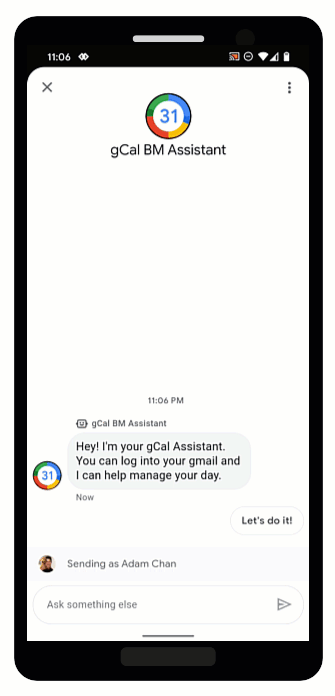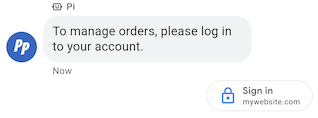
OAuth を使用すると、エージェントはユーザー ID を確認し、会話内の安全な方法でパーソナライズされた情報を提供できます。信頼できる OAuth プロバイダにユーザーがログインするようにすることで、エージェントはユーザーデータにアクセスでき、自動化によって素早く回答できるようになり、人間のエージェントにとって時間を節約できます。
ビジネス メッセージは、OAuth 2.0 をサポートし、認証リクエストの提案によって、ユーザーがエージェント用に構成した OAuth プロバイダにログインするように求めます。ユーザーがログインに成功すると、メッセージとして認証コードがエージェントに返されます。
OAuth プロバイダから認証コードを取得したら、それらの API と統合して、ユーザー ID 情報を必要とする会話フローをサポートできます。操作するサービスごとに利用規約が異なることにご注意ください。
エージェントの OAuth を構成する
エージェントの認証リクエストの提案を有効にするには、まず OAuth を構成する必要があります。
OAuth 構成を指定するには、Business Communications API を使用して PATCH リクエストを送信し、エージェントの endpointUrl フィールドを更新します。
エンドポイント URL を指定したら、エージェントのリダイレクト URI を保存し、OAuth プロバイダの情報でリダイレクト URI を更新する必要があります。
Prerequisites
次のものが必要です。
- OAuth 2.0 仕様に準拠する OAuth プロバイダ
- 開発マシン上の GCP プロジェクトのサービス アカウント キーのパス
エージェント
name(例: 「ブランド/12345/エージェント/67890」)エージェントの
nameがわからない場合は、ブランドのすべてのエージェントを一覧表示するをご覧ください。ユーザーが OAuth プロバイダにログインするためのエンドポイント URL
更新リクエストを送信する
エージェントを更新するには、次のコマンドを実行します。変数は、前提条件で特定した値に置き換えます。
curl -X PATCH \
"https://businesscommunications.googleapis.com/v1/brands/BRAND_ID/agents/AGENT_ID?updateMask=businessMessagesAgent.authorizationConfig" \
-H "Content-Type: application/json" \
-H "User-Agent: curl/business-communications" \
-H "$(oauth2l header --json PATH_TO_SERVICE_ACCOUNT_KEY businesscommunications)" \
-d "{
'businessMessagesAgent': {
'authorizationConfig': {
'endpointUrl': 'ENDPOINT_URL',
},
},
}"
リダイレクト URI を更新する
エージェント用に OAuth を構成したので、OAuth プロバイダに 4 つのリダイレクト URI を追加する必要があります。
https://business.google.com/callbackhttps://business.google.com/callback?https://business.google.com/message?az-intent-type=1https://business.google.com/message?az-intent-type=1&
OAuth プロバイダ情報にはすべてのリダイレクト URL を含める必要があります。
リダイレクト URI を更新するプロセスは、OAuth プロバイダによって異なります。手順については、OAuth プロバイダにお問い合わせください。
エージェントで OAuth を構成したので、認証リクエストの提案を使用してユーザーの認証を行うことができます。
ユーザーを認証する
エージェントの OAuth を構成すると、認証リクエストの提案を使用してユーザーにログインを促すことができます。
Prerequisites
次のものが必要です。
- 開発マシン上の GCP プロジェクトのサービス アカウント キーのパス
エージェント
name(例: 「ブランド/12345/エージェント/67890」)エージェントの
nameがわからない場合は、ブランドのすべてのエージェントを一覧表示するをご覧ください。OAuth プロバイダのクライアント ID
OAuth プロバイダによるコード チャレンジの要件
OAuth プロバイダのスコープ
認証リクエストの提案を送信する

ユーザーを認証するには、
- OAuth リクエストのコード検証ツールとコード チャレンジ文字列を生成します。 要件とオプションについては、OAuth プロバイダにお問い合わせください。
- 認証リクエストの提案を含むメッセージを送信します。
cURL
# Copyright 2021 Google LLC
#
# Licensed under the Apache License, Version 2.0 (the "License");
# you may not use this file except in compliance with the License.
# You may obtain a copy of the License at
# https://www.apache.org/licenses/LICENSE-2.0
# Unless required by applicable law or agreed to in writing, software
# distributed under the License is distributed on an "AS IS" BASIS,
# WITHOUT WARRANTIES OR CONDITIONS OF ANY KIND, either express or implied.
# See the License for the specific language governing permissions and
# limitations under the License.
# This code sends a text message to the user with an authentication request suggestion
# that allows the user to authenticate with OAuth. It also has a fallback text.
# Read more: https://developers.google.com/business-communications/business-messages/guides/how-to/message/send?hl=en#authentication-request-suggestion
# Replace the __CONVERSATION_ID__ with a conversation id that you can send messages to
# Make sure a service account key file exists at ./service_account_key.json
# Replace the __CLIENT_ID__
# Replace the __CODE_CHALLENGE__
# Replace the __SCOPE__
curl -X POST "https://businessmessages.googleapis.com/v1/conversations/__CONVERSATION_ID__/messages" \
-H "Content-Type: application/json" \
-H "User-Agent: curl/business-messages" \
-H "$(oauth2l header --json ./service_account_key.json businessmessages)" \
-d "{
'messageId': '$(uuidgen)',
'text': 'Sign in to continue the conversation.',
'fallback': 'Visit support.growingtreebank.com to continue.',
'suggestions': [
{
'authenticationRequest': {
'oauth': {
'clientId': '__CLIENT_ID__',
'codeChallenge': '__CODE_CHALLENGE__',
'scopes': [
'__SCOPE__',
],
},
},
},
],
'representative': {
'avatarImage': 'https://developers.google.com/identity/images/g-logo.png',
'displayName': 'Chatbot',
'representativeType': 'BOT'
}
}"
Node.js
/**
* This code sends a text message to the user with an authentication request suggestion
* that allows the user to authenticate with OAuth. It also has a fallback text.
* Read more: https://developers.google.com/business-communications/business-messages/guides/how-to/message/send?hl=en#authentication-request-suggestion
*
* This code is based on the https://github.com/google-business-communications/nodejs-businessmessages Node.js
* Business Messages client library.
*/
/**
* Before continuing, learn more about the prerequisites for authenticating
* with OAuth at: https://developers.google.com/business-communications/business-messages/guides/how-to/integrate/oauth?hl=en
*
* Edit the values below:
*/
const PATH_TO_SERVICE_ACCOUNT_KEY = './service_account_key.json';
const CONVERSATION_ID = 'EDIT_HERE';
const OAUTH_CLIENT_ID = 'EDIT_HERE';
const OAUTH_CODE_CHALLENGE = 'EDIT_HERE';
const OAUTH_SCOPE = 'EDIT_HERE';
const businessmessages = require('businessmessages');
const uuidv4 = require('uuid').v4;
const {google} = require('googleapis');
// Initialize the Business Messages API
const bmApi = new businessmessages.businessmessages_v1.Businessmessages({});
// Set the scope that we need for the Business Messages API
const scopes = [
'https://www.googleapis.com/auth/businessmessages',
];
// Set the private key to the service account file
const privatekey = require(PATH_TO_SERVICE_ACCOUNT_KEY);
/**
* Posts a message to the Business Messages API along with an authentication request.
*
* @param {string} conversationId The unique id for this user and agent.
* @param {string} representativeType A value of BOT or HUMAN.
*/
async function sendMessage(conversationId, representativeType) {
const authClient = await initCredentials();
if (authClient) {
// Create the payload for sending a message along with an authentication request
const apiParams = {
auth: authClient,
parent: 'conversations/' + conversationId,
resource: {
messageId: uuidv4(),
representative: {
representativeType: representativeType,
},
fallback: 'Visit support.growingtreebank.com to continue.',
text: 'Sign in to continue the conversation.',
suggestions: [
{
authenticationRequest: {
oauth: {
clientId: OAUTH_CLIENT_ID,
codeChallenge: OAUTH_CODE_CHALLENGE,
scopes: [OAUTH_SCOPE]
}
}
},
],
},
};
// Call the message create function using the
// Business Messages client library
bmApi.conversations.messages.create(apiParams,
{auth: authClient}, (err, response) => {
console.log(err);
console.log(response);
});
}
else {
console.log('Authentication failure.');
}
}
/**
* Initializes the Google credentials for calling the
* Business Messages API.
*/
async function initCredentials() {
// configure a JWT auth client
const authClient = new google.auth.JWT(
privatekey.client_email,
null,
privatekey.private_key,
scopes,
);
return new Promise(function(resolve, reject) {
// authenticate request
authClient.authorize(function(err, tokens) {
if (err) {
reject(false);
} else {
resolve(authClient);
}
});
});
}
sendMessage(CONVERSATION_ID, 'BOT');
Python
"""Sends a text message to the user with an authentication request suggestion.
It allows the user to authenticate with OAuth and has a fallback text.
Read more: https://developers.google.com/business-communications/business-messages/guides/how-to/message/send?hl=en#authentication-request-suggestion
This code is based on the https://github.com/google-business-communications/python-businessmessages
Python Business Messages client library.
"""
import uuid
from businessmessages import businessmessages_v1_client as bm_client
from businessmessages.businessmessages_v1_messages import BusinessMessagesAuthenticationRequest
from businessmessages.businessmessages_v1_messages import BusinessMessagesAuthenticationRequestOauth
from businessmessages.businessmessages_v1_messages import BusinessmessagesConversationsMessagesCreateRequest
from businessmessages.businessmessages_v1_messages import BusinessMessagesMessage
from businessmessages.businessmessages_v1_messages import BusinessMessagesRepresentative
from businessmessages.businessmessages_v1_messages import BusinessMessagesSuggestion
from oauth2client.service_account import ServiceAccountCredentials
# Before continuing, learn more about the prerequisites for authenticating
# with OAuth at: https://developers.google.com/business-communications/business-messages/guides/how-to/integrate/oauth?hl=en
# Edit the values below:
path_to_service_account_key = './service_account_key.json'
conversation_id = 'EDIT_HERE'
oauth_client_id = 'EDIT_HERE'
oauth_code_challenge = 'EDIT_HERE'
oauth_scope = 'EDIT_HERE'
credentials = ServiceAccountCredentials.from_json_keyfile_name(
path_to_service_account_key,
scopes=['https://www.googleapis.com/auth/businessmessages'])
client = bm_client.BusinessmessagesV1(credentials=credentials)
representative_type_as_string = 'BOT'
if representative_type_as_string == 'BOT':
representative_type = BusinessMessagesRepresentative.RepresentativeTypeValueValuesEnum.BOT
else:
representative_type = BusinessMessagesRepresentative.RepresentativeTypeValueValuesEnum.HUMAN
# Create a text message with an authentication request
message = BusinessMessagesMessage(
messageId=str(uuid.uuid4().int),
representative=BusinessMessagesRepresentative(
representativeType=representative_type
),
text='Sign in to continue the conversation.',
fallback='Visit support.growingtreebank.com to continue.',
suggestions=[
BusinessMessagesSuggestion(
authenticationRequest=BusinessMessagesAuthenticationRequest(
oauth=BusinessMessagesAuthenticationRequestOauth(
clientId=oauth_client_id,
codeChallenge=oauth_code_challenge,
scopes=[oauth_scope])
)
),
]
)
# Create the message request
create_request = BusinessmessagesConversationsMessagesCreateRequest(
businessMessagesMessage=message,
parent='conversations/' + conversation_id)
# Send the message
bm_client.BusinessmessagesV1.ConversationsMessagesService(
client=client).Create(request=create_request)
- ユーザーが候補をタップして正常にログインすると、エージェントの Webhook にメッセージが受信されます。
authenticationResponse.codeフィールドから認証コードを取得します。
メッセージを受信したら、認証プロバイダと認証ベンダーを OAuth プロバイダからのアクセス トークンと交換できます。アクセストークンを使用してユーザーデータにアクセスできます。
コードサンプルを含む認証の会話例については、ユーザーを認証するをご覧ください。
